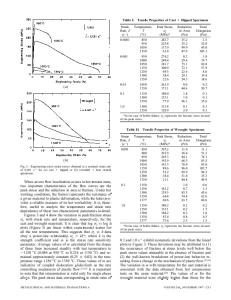Microstructure Evolution and Mechanical Properties of AQ80 Alloy During Forward Extrusion and Twist Deformation
- PDF / 1,843,177 Bytes
- 10 Pages / 593.972 x 792 pts Page_size
- 67 Downloads / 377 Views
JMEPEG https://doi.org/10.1007/s11665-020-05104-1
Microstructure Evolution and Mechanical Properties of AQ80 Alloy During Forward Extrusion and Twist Deformation Xiaoye Liu, Liwei Lu, Min Ma, Wei Kang, Bo Che, and Yong Xue (Submitted January 22, 2020; in revised form August 20, 2020) A new severe plastic deformation technique, forward extrusion and twist deformation, was adopted to manufacture magnesium (Mg) alloys at different temperatures. The microstructure evolution and mechanical properties of extruded AQ80 alloy were investigated. The strain distribution in FETD extrusion was simulated with finite element simulation software. The extruded samples exhibit finer grain sizes, weaker basal textures, higher recrystallized volume fractions and higher strengths than the traditional forward extrusion samples. This technology can refine the microstructure and improve the mechanical properties of Mg alloys. At lower temperatures, the grain size is smaller with a finer second phase, which is detected as Mg17AL12. Mg17AL12 has a particle-stimulated nucleation effect and a retarding effect on grain growth, resulting in much finer DRXed grains. Due to the effects of fine-grained strengthening and second phase strengthening, the strength and elongation of AQ80 alloy can be improved significantly. Keywords
AQ80 Mg alloy, mechanical property, microstructure, SPD technology
1. Introduction As one of the lightest structural engineering platform materials, magnesium (Mg) and its alloys have been developed quickly in recent decades due to the increasing demand for lightweight structural materials (Ref 1-4). However, their wider applications remain limited due to their hexagonal close-packed (HCP) structure, which leads to tension–compression yield asymmetry and lower extrudability (Ref 5). Cast Mg alloys have inherent shortcomings, such as casting defects. Thus,
Xiaoye Liu, Hunan Provincial Key Laboratory of High Efficiency and Precision Machining of Difficult-to-Cut Material, Hunan University of Science and Technology, Xiangtan 411201 Hunan, PeopleÕs Republic of China; Liwei Lu, Hunan Provincial Key Laboratory of High Efficiency and Precision Machining of Difficult-to-Cut Material, Hunan University of Science and Technology, Xiangtan 411201 Hunan, PeopleÕs Republic of China; College of Materials Science and Engineering, Hunan University of Science and Technology, Xiangtan 411201 Hunan, PeopleÕs Republic of China; and Hunan Provincial Overseas-Wisdom Innovation Center of New Energy Vehicles in Industrial-Academic-Research Cooperation, Hunan University of Science and Technology, Xiangtan 411201 Hunan, PeopleÕs Republic of China; Min Ma, Wei Kang, and Bo Che, College of Materials Science and Engineering, Hunan University of Science and Technology, Xiangtan 411201 Hunan, PeopleÕs Republic of China; and Hunan Provincial Overseas-Wisdom Innovation Center of New Energy Vehicles in Industrial-Academic-Research Cooperation, Hunan University of Science and Technology, Xiangtan 411201 Hunan, PeopleÕs Republic of China; and Yong Xue, School of Mate
Data Loading...











